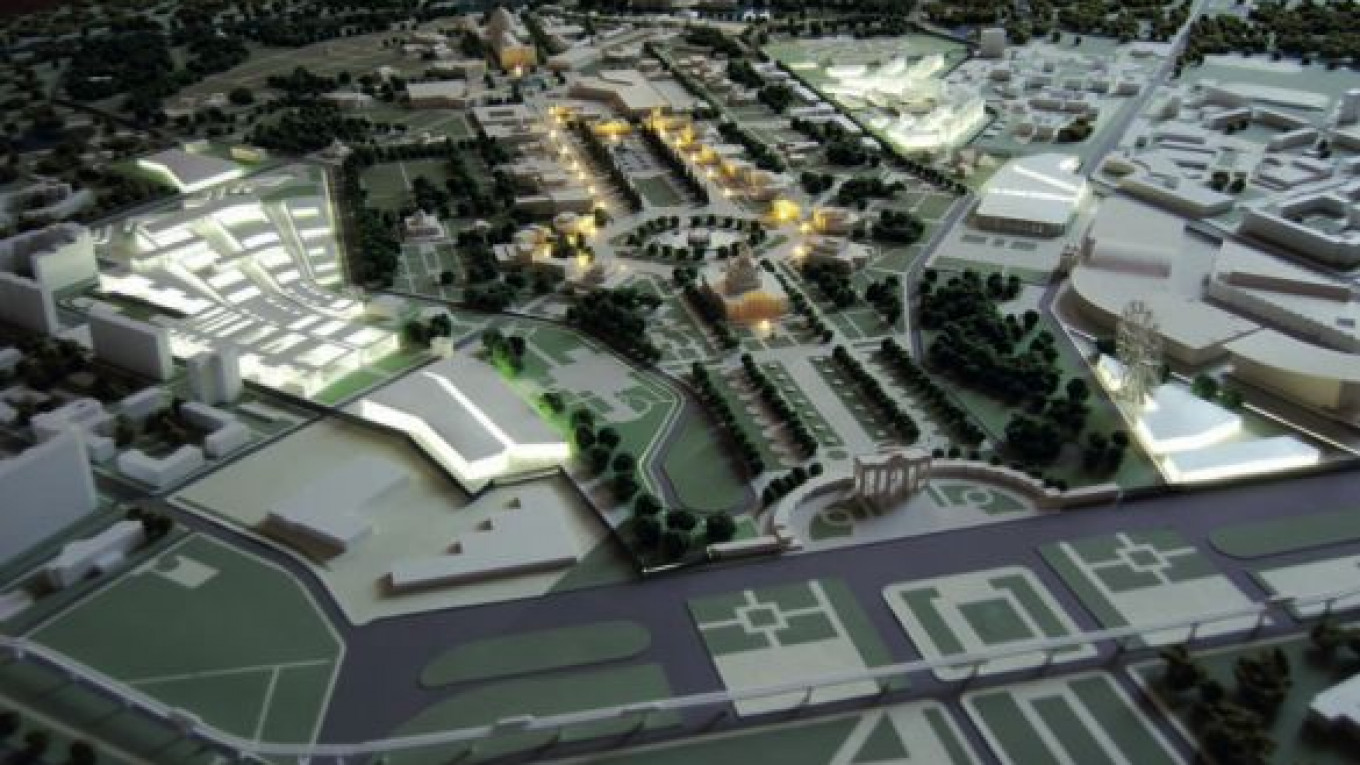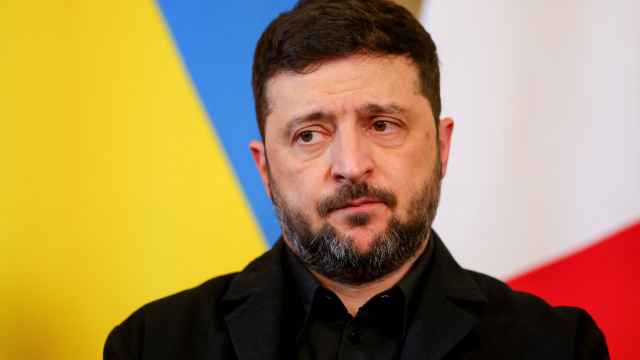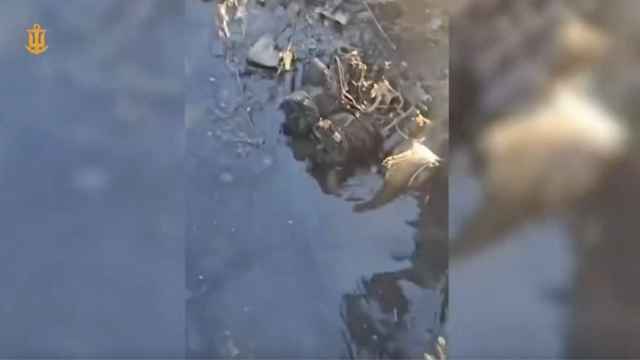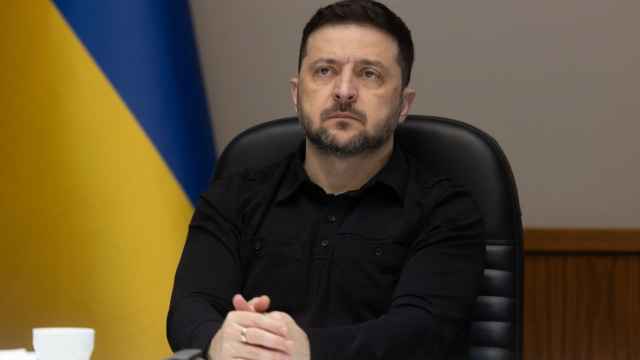More than 20 years after the fall of communism, the Soviet splendor of the All-Russia Exhibition Center is finally set to collide with the realities of modern Russia as a $1.5 billion modernization program gets underway in 2012.
The five-year development plan for the "rebirth" of the famous site that attracts an average of 40,000 daily visitors includes the construction of an innovation center, indoor leisure park and luxury hotels.
Previous efforts to upgrade the All-Russia Exhibition Center, or VVTs, have been half-hearted, or hit a brick wall of legal complications. Opened in 1939 by Soviet Premier Vyacheslav Molotov, the VVTs received its present name in 1992. After 1959 it was known as the Exhibition of National Economic Achievements, or VDNKh, an abbreviation that many still use.
Aside from some superficial repairs, its 70 pavilions that once displayed the industrial, agricultural and technological achievements of the Soviet Union have enjoyed little investment since the collapse of communism. During the 1990s, they were colonized by traders selling anything from seedlings to fur hats and by small exhibitions devoted to celebrities, waxworks and live animals.
Mismanagement has also played a role. Two forlorn white statues remain after the hunting and fishing pavilion burned down in 2005. In 2008, a Tu-154 plane was dismantled and removed despite a popular outcry. More recently, on Aug. 30, a huge fire that spread over a square kilometer destroyed the 1930s veterinary science pavilion.
More than two decades of parsimony and neglect is obvious to any visitor. Many pavilions have disintegrating facades and crumbling bas-relief interiors. When it rains the enormous glass dome of the iconic space pavilion, whose exhibits disappeared in the 1990s, leaks onto its empty floor.
The company that runs the VVTs is 70 percent owned by the federal government and 30 percent by City Hall. A new director, Alexei Mikushko, was appointed in September. Formerly responsible for the renovation of the former Hotel Ukraina — now the Radisson Royal Hotel — Mikushko told a news conference Friday that, "over the last 20 years the appearance of the VVTs has changed for the worse."
He added that after its renovation, the site would again be one of Russia's "pearls." In contrast to his predecessor in the job, Ivan Malakhov, who stated that modernization could continue up to 2034, Mikushko said the bulk of the process would be completed within six years.
Under the rejuvenation plan outlined to journalists, five zones will be created within the 236-hectare site that contains 615 buildings. The cultural-historical zone will encompass the central walkway and the most dramatic pavilions and fountains and will be surrounded with an innovation campus, quality-of-life center, exhibition-conference center and large leisure zone.
Underground parking lots and at least two four-star hotels will also be built as well as the establishment of new museums and a complete overhaul of heating, electricity, sewage and water-provision infrastructure.
Saida Gadlia, who sells seeds and gardening equipment from a small booth near the VVTs southern entrance, told The Moscow Times that she had heard rumors of approaching changes.
"There's a new law and a new boss," said Gadlia, who has worked there for three years. She said that if the redevelopment went ahead, there was no chance that her shop would survive.
It is located on VVTs territory slated for the erection of an indoor entertainment park — part of the quality-of-life center. In materials distributed to journalists, the entertainment park was compared to Las Vegas' Venetian Hotel and Japan's Seagaia Ocean Dome, the world's largest water park.
Of a total $1.5 billion due to be invested, $500 million will go to the restoration of the historical pavilions. The cultural-historical zone, in which these pavilions are concentrated, will become a "Park of the Soviet period" that will be used as a background for costumed actors and Soviet parade re-enactments.
Mikushko stressed that VVTs was of interest to foreigners who, he said, were drawn by the imperial architectural style that flourished under Josef Stalin.
But one British tourist who visited Russia for the first time this summer said the appeal for foreign visitors was subtler.
"The VVTs retains its charm because capitalism has been transplanted onto it in such a haphazard fashion," Florence Sutcliffe-Braithwaite, a graduate student of modern history at Cambridge University told The Moscow Times. "The pavilions will always be a wonder to behold, but if an upscale development goes ahead, the VVTs will most likely become a symbol of a newer Russia where everything is expensive and nothing is that much fun."
Some of the most extravagant pavilions on the site are those that once housed the industrial achievements of Soviet republics. Mikushko said Kyrgyzstan, Armenia and Kazakhstan have already agreed to rent their respective pavilions for a symbolic 1 ruble (3 cents) annual payment. Agreements with Moldova and Azerbaijan are expected before the end of the year.
Prime Minister Vladimir Putin announced that the pavilions could be rented on such symbolic terms in November 2010 at a meeting of Russia and CIS countries.
Inna Markovskaya, a honey-seller in the panoramic cinema and one of the 1,500 people who work on the site, told The Moscow Times that if someone was willing to invest money in the VVTs, they should be encouraged. "I'm not a fan of tumbledown buildings," she said.
Under the plans, an estimated $226 million will be spent on infrastructure renewal, while a further $324 million will be required to buy out the 87 properties held by private owners. The innovation campus to be built in the east of the VVTs will involve big state corporations including Rosneft, Gazprom and Rusnano.
Alongside government money, private investors will also be involved in financing the project, Mikushko said. He declined to give any names. "Of course, there will be a commercial part," he said.
Concerns have been expressed over whether the reconstruction of the VVTs will irreversibly change its atmosphere and its unique architectural integrity.
Oleg Lad, who has sold jewelry in the 66th pavilion for the last two years, said the success of the project depended on the sophistication of those carrying it out. "The cultural level of the people doing the reconstruction should be very high — unfortunately there are very few such people," he told The Moscow Times.
At present, the entire territory of the VVTs is a protected zone and 29 of its 615 buildings are officially designated as "monuments of architecture."
But to pave the way for development, VVTs head architect Vladimir Kabanov said Friday that "we have to actualize — I would not say remove — the protected status." The VVTs status will be altered to that of a "notable place," he said. The legal process for implementing this has not yet been completed, but Kabanov added that it is in its "final stages."
The switch to a "notable place" designation would be "dangerous" because it gives more leeway to developers, Natalya Samover, an activist with architectural preservation group Arkhnadzor, told The Moscow Times. As the VVTs company has significant administrative resources, she said, it would have more flexibility to bend the rules as far as possible.
Samover added that she distrusts the VVTs authorities. After the veterinary science pavilion burned to the ground in August, an official statement said the 1939 colonnaded wood construction was not a monument of architecture and "had no value."
"If we lose these sorts of monuments, we will begin to lose an understanding of what communism strove after and what happened in our country during the 1940s and 1950s," Samover said.
Several pavilions located on the edges of the exhibition's territory will have to be incorporated into the new buildings, if they are not destroyed under the existing plans.
In the southern part of the VVTs, for example, both the panoramic cinema and the Brezhnev-era seed pavilion are on the site of the planned entertainment complex. Other pavilions fall under the innovation campus and hotel on the territory's eastern edge.
Samover said the seed pavilion was a work of modernist architecture and was now under direct threat.
But Boris Levyant, the architect who drew up the VVTs "rebirth" concept plan, said pavilions like the seed pavilion would be "integrated" into the entertainment complex. "Their essence will not be lost, but they won't be standing by themselves," he said.
Notwithstanding the reception among investors, visitors and preservationists, the designers behind the plans for the VVTs will be hoping to be present at their realization in 2016.
The original architect for the VVTs was not so lucky. A victim of Stalinist repression, Vyacheslav Oltarzhevsky only heard that his brainchild had opened to the public in 1939 by chance. He was serving a three-year prison term in a Siberian labor camp.
A Message from The Moscow Times:
Dear readers,
We are facing unprecedented challenges. Russia's Prosecutor General's Office has designated The Moscow Times as an "undesirable" organization, criminalizing our work and putting our staff at risk of prosecution. This follows our earlier unjust labeling as a "foreign agent."
These actions are direct attempts to silence independent journalism in Russia. The authorities claim our work "discredits the decisions of the Russian leadership." We see things differently: we strive to provide accurate, unbiased reporting on Russia.
We, the journalists of The Moscow Times, refuse to be silenced. But to continue our work, we need your help.
Your support, no matter how small, makes a world of difference. If you can, please support us monthly starting from just $2. It's quick to set up, and every contribution makes a significant impact.
By supporting The Moscow Times, you're defending open, independent journalism in the face of repression. Thank you for standing with us.
Remind me later.







